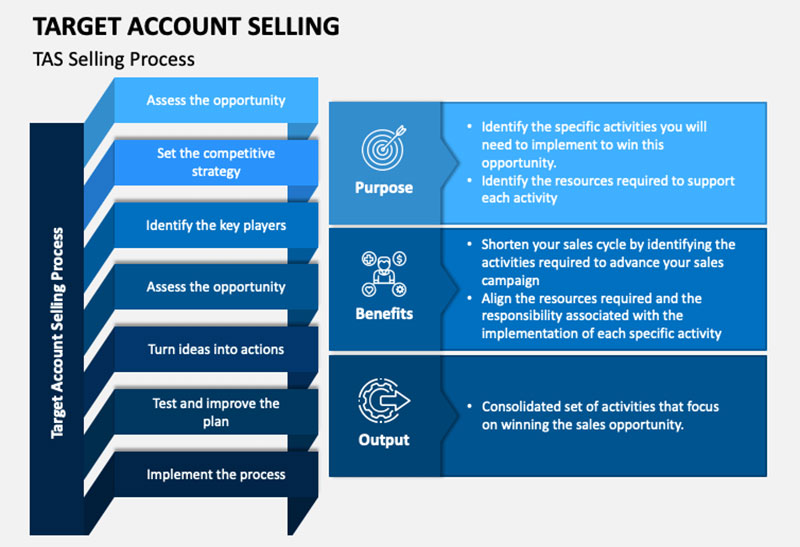Target account selling is a sales method that provides clear focus and direction. The TAS approach effectively uses a company's time and resources to get good leads. It also personalizes sales.
The target account selling methodology requires sales reps to deliver marketing plans tailored to each lead. This competitive strategy emphasizes quality sales calls over quantity.
This article will discuss target account selling: What it is, what it means for businesses, and why it works.
What is Target Account Selling?

Target account selling (TAS) is a business-to-business sales approach. As the name implies, it means that businesses target potential accounts. A sales team targets a set of highly qualified leads.
The structured and well-researched marketing strategies (TAS sales strategy) successfully convert leads because of the personalized approach.
Target account selling focuses on nurturing customer-centric relationships. Sales professionals use the TAS strategy to research businesses that make suitable customers. Then they deliver customized sales plans tailored to that business's needs and pain points.
A major difference between the target account selling strategy and other sales techniques is the point of contact. Instead of reaching out to a single point of contact, sales representatives get in touch with multiple decision-makers.
Target account selling yields fewer but larger sales. It focuses on lead quality and not lead quantity. Using this sales process ensures more efficient resource allocation.
Instead of the sales team wasting their time chasing several leads that may or may not close, they focus on more promising leads. They get to know and understand potential clients. With this knowledge, they can deliver personalized experiences and close on bigger sales.
The target account selling method requires extensive research and collecting ample lead information. It also makes the sales cycle a little more complex. But overall, the increased revenue makes this sales methodology worthwhile.
When Should Sales and Marketing Teams Use the TAS Method?
All companies can benefit from this strategy. But the companies that benefit most from the TAS sales technique offer subscription-based products and tiered pricing. They also have a lot of opportunities to upsell and cross-sell.
Of course, for TAS marketing campaigns to work, companies need access to the right information. They need access to service desk information, market research, CRM data, etc.
This information helps build target account selling templates. Basically, the more information and the more familiar a sales team is with target accounts, the more successful they will be.
How Does the Target Account Selling Methodology Work?
Target account selling requires collaboration between marketing, sales, and customer success teams. It takes time to research and collect detailed information about each account.
Sales teams need to learn everything possible about a lead. Then they can provide assistance and communication all the way through the sales funnel to the close of the sale and beyond.
The three teams collaborate on the following three steps:
Step One
Sales and marketing teams work together to build an ideal customer profile. An ideal customer profile is a theoretical representation of an ideal customer.
The profile consists of the general characteristics that make a customer a good fit. It narrows a company's focus to accounts that would benefit the most from their services.
To begin writing an ideal customer profile, think about your current customers. What is their industry? How much do they pay? What kind of value does your service provide to them? Use the answers to these questions to help create the ideal customer profile.
The profile should include the following characteristics:
- industry
- business size
- geographical location
- budget
- pain points
- decision-making factors
- business objectives
- notable attributes
After creating an ideal customer profile, sales teams can then target customers that fit that profile. This ensures that valuable time is not wasted contacting potential customers unless they are already a good fit.
Starting with potential customers who are a good fit for the company creates a recipe for success. So after conducting research and developing the ideal customer profile, a company can start building a list of target accounts.
The goal is to select a handful of key accounts to start the sales process. It is best to have a few targeted accounts so that you can have a higher level of engagement.
Companies need to strike a balance with the right number of accounts. Too many accounts will leave fewer resources to provide a personalized journey. And too few accounts limit potential.
The best way to strike a balance is to prioritize accounts based on marketing campaigns. No one engages all their target accounts in one campaign because doing so would overwhelm sales professionals and be an ineffective use of resources.
Instead, rank the accounts using data points, technology, and research. Most business-to-business companies use a three-tiered prioritizing system.
The three tiers are:
- Accounts perfectly fitting the ideal customer profile
- Accounts that are solid fits but have a lower lifetime value
- Accounts that fill most but not all the ideal customer criteria. They are worth pursuing but are not worth investing a significant amount of resources
Using a priority system allows companies to allocate resources to accounts that can drive more revenue. It also adds strategic value to their business.
Step Two
Once a clear ideal customer profile is established, the sales team still needs to do thorough research. They need to research each qualified account. This includes creating a detailed and unique buyer persona for each key decision-maker.
The buyer persona is more specific than the ideal customer profile. Getting to know the person better allows sales representatives to customize their content and nurture the lead by addressing unique pain points.
The buyer persona should include information like:
- the person's background (job, career, family, etc.)
- demographics (age, gender, income, etc.)
- personality identifiers (demeanor)
- communication methods (email, mail, in-person, virtual meetings, etc.)
Step Three
During the buying process, marketing and sales teams need to provide support to each stakeholder. They need to answer questions, provide resources, testimonials, and more. Being consistently available and offering assistance will contribute to closing the deal.
Once the deal is closed, the account is handed over to the customer success team. That team provides help with the onboarding process and solution implementation.
The customer success team can provide valuable insight into customer experiences that will help target future accounts. So the sales and marketing teams need to stay in close communication with them.
Target Account List
A target account list (TAL) is the list of accounts that a company plans to target in its marketing efforts. The target account list should be potential clients that fit the ideal customer profile. This list should reflect everything a company knows about the account.
Building a target account list is a vital part of the target account selling method. With a TAL, a sales representative can create high-value marketing campaigns tailored to individual needs.
Having a detailed target account list will help develop a targeted sales campaign, design new campaign content, and know who the sales team should cold call or email.
Extensive research needs to be conducted to build the ideal customer profile and the target account list. Information for these two lists can come from the following sources:
- Industry reports
- Account intelligence: information gathered from ideal customers and software platforms
- Competitor intelligence: data collected from a competitor assessment
- Marketing intelligence: a broad look at the economy and disruptions or advancements to your market or the customers market to figure out which accounts present opportunities for future growth
- Feedback: customer feedback collected from customer service and sales representatives
Campaign success depends on the quality of the target account list. The TAL will affect the entire sales cycle and play a crucial role in closing leads. Make sure to ask for feedback on how good the TAL is so that you can make improvements.
Why Target Account Selling Increases Deals
The target account selling method can be complex at first because it is time-consuming and takes more resources than usual to win over a client.
Companies need extensive access to customer data so that sales representatives have a deeper understanding of each lead they approach. Additionally, sales professionals need to design custom plans for each account.
Despite these challenges, the TAS methodology can yield rich results. It generates the following benefits:
Stronger Relationships
The target account selling strategy revolves around building meaningful and long-lasting relationships. Personalized content, customized plans, and ongoing support are the core principles of TAS.
Key decision-makers will be ready to jump into business when they trust the solutions you offer. Building these strong relationships and a trustworthy rapport turns leads into clients. Strong relationships also mean that clients will stay with you longer.
Accelerated Sales Cycle
TAS takes more time and research upfront, and it might complicate the sales cycle a little, but it can also accelerate it. It accelerates it because it wastes less time on leads that do not convert. The bulk of resources and time are directed towards accounts that are more likely to convert and be profitable.
Market Penetration
The target account selling technique allows companies to capture a higher percentage of the market share. That is because it hones in on the most qualified accounts. Then, it presents those accounts with tailored, valuable, and irresistible solutions.
Companies, too, are willing to pay more for customized solutions that give them the tools they need to grow. Combining customized solutions with good customer service creates an unmatchable offer sure to boost the bottom line.
Ending thoughts on target account selling
The business-to-business landscape is ever-evolving. In the current climate, companies are valuing personalized offers more and more.
So target account selling is a competitive sales technique that produces excellent results. Building solid relationships and providing tailored offers drive business growth and increase revenue.
Being successful with the TAS method takes effort. It also requires a collaborative spirit in the marketing, sales, and customer success teams.
The main building blocks of the target account selling method are:
- thorough research
- targeted marketing campaigns
- open communication
- continuous customer support
Yes, it takes a lot of hard work to implement the target account selling strategy. But it gets easier and more efficient once the processes are in place and companies get more familiar with their target accounts.
After implementing this strategy, relationships will get stronger, sales will be more effective, and the company will be more profitable.
If you enjoyed reading this article on target account selling, you should check out this one about lead generation techniques.
We also wrote about a few related subjects like sales automation tools, sales funnel examples, how to sell SaaS, best sales apps, useful elevator pitch examples, sales pipeline stages, cold calling vs. warm calling, and sales automation software.


